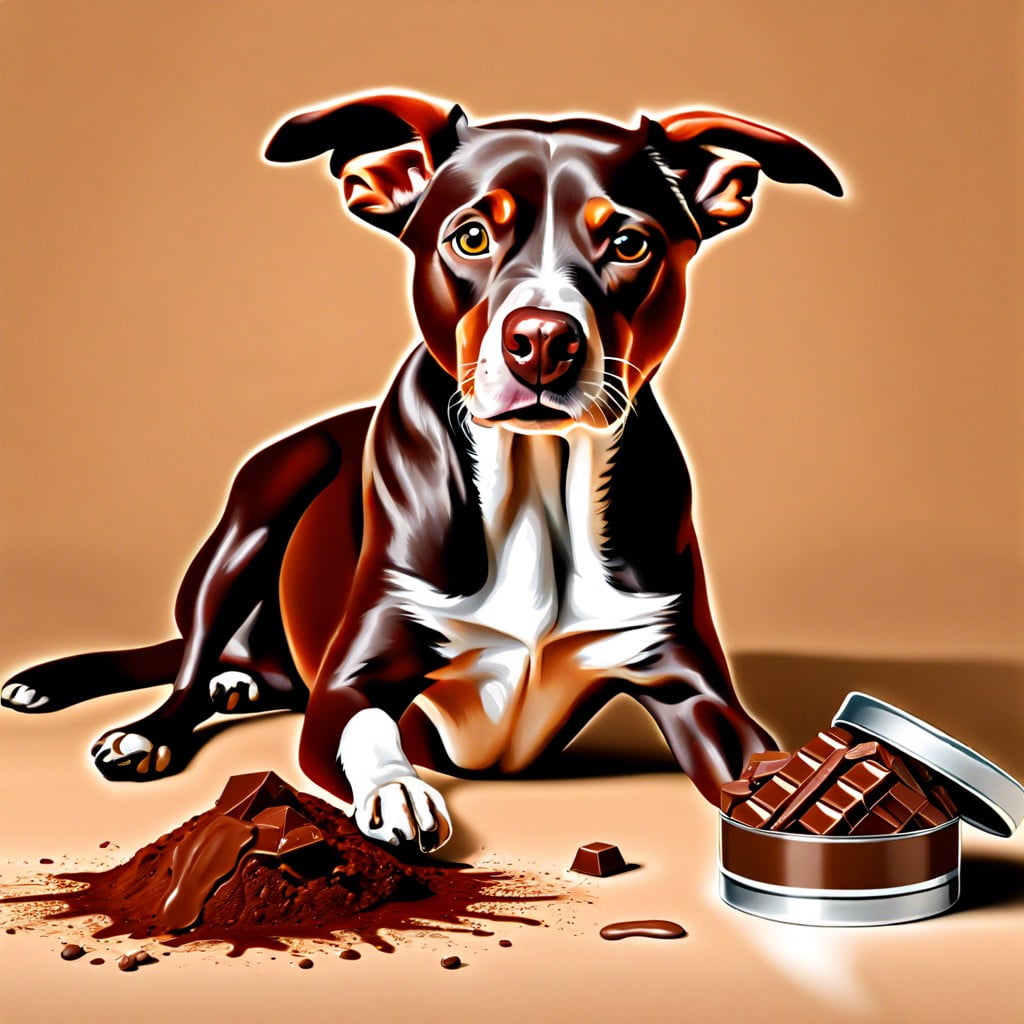My dog ate chocolate but seems fine—here’s what you need to know and how to keep your furry friend safe.
Key takeaways:
- Signs of chocolate poisoning in dogs: vomiting, diarrhea, hyperactivity, rapid breathing, tremors.
- When to take your dog to a veterinarian: excessive drooling, unusual hyperactivity or sleepiness, muscle tremors or seizures.
- How much chocolate is dangerous for dogs: depends on size and type, dark chocolate is most harmful.
- Does the type of chocolate matter: dark chocolate is most dangerous, milk chocolate can still be harmful, white chocolate is least worrisome.
- Steps to take if your dog eats chocolate: stay calm, remove chocolate, determine amount and type, call vet, follow vet’s instructions, monitor for symptoms, prevent future access.
Inside
Signs of Chocolate Poisoning in Dogs

Your dog may look like a happy, tail-wagging chocolate muncher, but the real story could be dark. Watch for symptoms such as vomiting and diarrhea. These signs might pop up pretty quickly.
Your pooch acting like a kangaroo on an espresso binge? Hyperactivity is another red flag. Chocolate contains theobromine, a substance dogs process more slowly than humans.
Heart racing like it’s about to win a marathon? Tremors and rapid breathing can be ominous signals.
Don’t let that dopey grin fool you. Muscle rigidity, a wobbly gait, and seizures are serious indicators. If your dog morphs into a shaky, uncoordinated mess, it’s time to take swift action.
Keep an eye on that furry friend. The signs may be subtle at first but can quickly escalate.
When to Take Your Dog to a Veterinarian
First things first, don’t panic! Dogs are masters at giving us heart attacks. But sometimes, they bounce back like they’re made of rubber.
Look out for signs like vomiting, diarrhea, or excessive drooling. These are the doggy alarm bells.
If your furball seems unusually hyperactive or, ironically, extra sleepy, it could be a clue.
Muscle tremors or seizures? That’s DEFCON 1. Get moving to the vet.
Trust your instincts. If your furry friend just doesn’t seem right, better safe than sorry.
How Much Chocolate Is Dangerous for Dogs
Even if your furry friend seems fine after munching on some chocolate, knowing how much is too much can save their wagging tail. Here’s the scoop:
First, it depends on the size of your dog. A tiny chihuahua will feel the effects much quicker than a burly St. Bernard.
Second, the type of chocolate plays a big role. Dark chocolate is the villain here, with higher theobromine levels than its milk or white counterparts.
- Here are some quick examples:
- White chocolate: Not totally safe but least harmful.
- Milk chocolate: Moderately dangerous; consumption rate matters.
- Dark chocolate: More theobromine, more trouble.
For a ballpark figure, about one ounce per pound of body weight is harmful for milk chocolate. Dark chocolate is more potent; it takes less to cause harm.
Remember, even small amounts might cause issues, so better safe than sorry.
Does the Type of Chocolate Ingested Matter
Absolutely, the type of chocolate can make a world of difference. Each variant contains different levels of theobromine, the chemical compound that makes dogs teeter-totter between “I’m fine” and “I need a vet!”
Dark chocolate is the heavyweight champion of danger. It’s got the most theobromine, making it the most hazardous, even in small amounts. Think of dark chocolate as a fierce dragon. A tiny nibble can spew big trouble.
Milk chocolate, while not as bad, can still pack a punch. Your dog would need to munch on quite a bit more to get into serious trouble, but it’s still no all-you-can-eat buffet.
White chocolate, the faux-chocolate cousin, is mostly cocoa butter with negligible theobromine levels. It’s the least of your worries, but still, it’s not an excuse for a white chocolate binge!
Remember: baking chocolate is the villain in disguise. Super concentrated and ultra dangerous. Even small amounts can spell disaster.
Different chocolates, different risks. It’s a choco-jungle out there! Always be on alert.
Steps to Take If Your Dog Eats Chocolate
First, don’t panic! Stay as calm as a cucumber with a Netflix subscription. Get your dog away from the chocolate, just in case they’re plotting a sequel.
Next, determine how much chocolate was consumed and what type. This detective work can help your vet; they’re basically Sherlock Holmes for pets.
Call your vet, pronto. They’ll offer specific advice based on the severity of the situation. If it’s after-hours, veterinary emergency hotlines are the night owls of the pet-med world.
Your vet may suggest inducing vomiting. Don’t start without instructions. We don’t want your dog reenacting scenes from The Exorcist without a good reason.
Activated charcoal might be recommended. Nope, it’s not for your dog’s Instagram filter. It helps absorb toxins. Again, follow your vet’s guidance.
Keep close tabs on your dog for any odd behavior or symptoms. Think of yourself as their personal bodyguard, without the sunglasses and earpiece.
Finally, prevention is key. Store chocolates out of reach, in a place even the most cunning of canines can’t infiltrate.
Related
- Why Can’t Dogs Eat Chocolate: Understanding The Risks for Your Pet
- How Much Chocolate Can Kill a Dog: Essential Info for Pet Owners
- Is Chocolate Bad for Dogs: Understanding the Effects on Canine Health
- Dog Ate Chocolate: What to Do and How to Prevent It
- Why is Chocolate Bad for Dogs: Crucial Information for Pet Owners